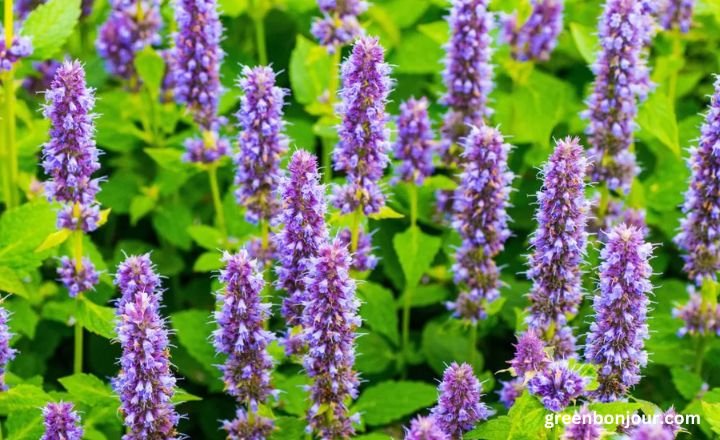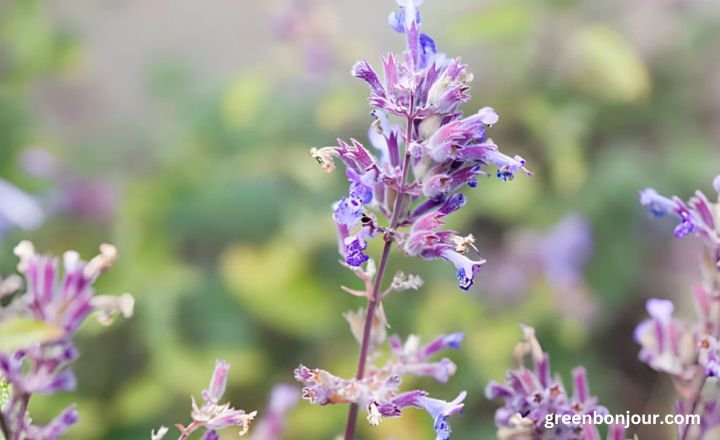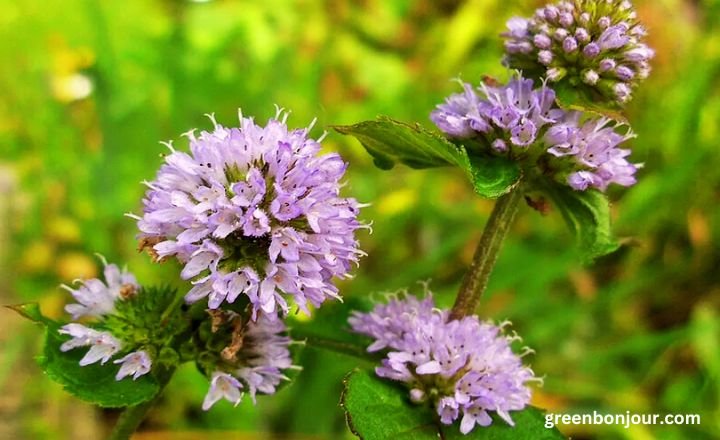When you grow plants with purple flowers in your garden, you must feel the need to grow some herbs with them. They are capable of enhancing the beauty of your garden. There is a huge variety of herbs that can be grown in your garden along with purple flowers. If you grow them in your garden, you will definitely love them.
By walking in the market, you will come to know that there are lots of herbs that can easily be grown in your garden without putting much effort. You should learn about purple herbs so that you don’t find it difficult to grow them.
15+ beautiful herbs with purple flowers names and pictures
These herbs are famous in the market, according to Rhs-qualified horticulturist Colin Skelly:
“You’ll also enjoy the sight and sound of plentiful pollinators through the growing season because purple-blue is bees’ favorite color and purple-blue flowers tend to have high levels of nectar”.
Let’s dive in to learn names of purple flowers:
Lavender
The scientific name for lavender is Lavandula angustifolia but it is commonly known as Lavandula. These purple plants belong to the mint family. Lavender usually blooms in the summer season this indicates that you should do this little before the summer. They start blooming in the summer and this lasts for at least four weeks.

Lavender is a purple flower that is famous for its fragrance. You need to fulfill some requirements to keep them in a better condition. You have to keep them in average pH soil. They need proper lighting and you have to follow a proper water schedule. You don’t need to water them daily; you only need to water them twice a year.
Rosemary
The scientific name for this plant is Salvia Rosmarinus. You will find them green always so this is known as the evergreen plant. You can grow them in your garden you get their benefits and enjoy their nature. They have a pleasant smell that fascinates people. They are also good for human hair growth, you can use them for that purpose after growing them.

They used to bloom in the spring season and these last up to late summer. You can use them to enhance the taste of foodstuffs. They are capable of resisting the pests’ attack. They are easy to grow, you only need to take care of your purple color or flower. If you want them in good condition then you have to provide them with proper sunlight, they want fertilizer for better growth. Also, a healthy watering schedule and fresh air are needed.
Anise Hyssop
Anise Hyssop is scientifically known as Agastache foeniculum. This rare variety often confuses people because it resembles lavender. It grows in bushes and displays purple sprigs on long stalks. It has some medical benefits, such as curing fevers, diarrhea, wounds, and coughs.
They are perennial plants. They originally came from the North America Plains. They usually grow up to 4 feet tall. They need to give them part sun and full sun as well. They fall under the USDA zone 5.

The flowers are conical, and one plant has a great number of them, attracting butterflies, bumblebees, hummingbirds, and other pollinators in droves. They produce pale purple to deep indigo flowers, and they can be grown in gardens, containers, raised beds, and meadows.
Catnip
Nepeta cataria is the scientific name for catnip. They produce purple flowers and possess an attractive fragrance as well. They are mainly famous for their different names like catwort, catswort, and catmint. They can be grown in the home gardens easily, you just need to struggle and learn all about them.

They prefer full sunlight and can also survive in partially shady areas. When you give them well-drained soil, you will find them happy and dancing. If you want to give them fertilizers then you can provide them with but only a few fertilizers are enough to grow them. They have a lot of benefits but the common one is you can use them in salad.
Oregano
The scientific name for Oregano is Origanum vulgare but they commonly known as oregano. They are familiar to kitchen lovers because the leaves of oregano are an important ingredient used in the kitchen, A very few amount of oregano leaves is enough to give the dishes a unique taste.

These plants are attractive and practical for the house and yard. Their petals exist in the combo colors that are pinkish and purple. When you use its fresh leaves it adds nutrients to your food. But its dry leaves are also used by people.
Thyme
The thyme is scientifically known as Thymus vulgaris but is commonly known as thyme. It is an evergreen shrub that produces small and bluish-green leaves and has a woody base. This plant is full of tannins, minerals, organic acids, bitter chemicals, and vitamins A and B. You can grow them and can get these benefits.

If you want to grow them you need to follow and fulfill these requirements. They need full sunlight for the best growth of the plant. They prefer well-drained soil with pH levels of 6 to 8. They usually bloom the flowers in the summer season. Their hardiness varies from USDA hardiness zones 2-10.
Spearmint
The scientific name for spearmint is Mentha spicata. They have a lot of names such as Common mint, lamb mint, garden mint, and mackerel mint. You can use it in many recipes, they can also be added to drinks. You can make a mint sauce with this, these can be used in salads. The only thing this herb needs is frequent supervision.

They require partial sunlight so you should avoid giving them full sunlight. The purple flower plant used to bloom in the summer season. Their hardiness lever is h7. They want poorly drained soil. You have to take care of them until they bloom successfully.
Chives
Allium schoenoprasum is the scientific name of chives. They originally came from North America, Europe, and Asia. You can use it to make your salad delicious because their taste resembles the taste of onion. It has many benefits as it can be used to cure cancer and also improve bone health.

You should learn their basic needs, as they want ideal sunlight, and they can survive in any kind of soil. Their hardiness level is h6. They used to bloom in the summer. You can cultivate them inside your garden. They just need frequent fertilization and proper sunlight. Chives companion plants include carrots, grapes, potatoes, etc.
Sage
Salvia officinalis is the scientific name for this purple flower plant. But they are commonly known as garden sage. They produce evergreen gray leaves that make them special and unique in all varieties. With these evergreen gray leaves, they produce woody stems. They have beneficial components in them, or you can say that they are rich in important ingredients.

These beneficial elements are rosmarinic acid, vitamin K, manganese, iron, calcium, and vitamin B6. you need to give them full sunlight but they can also survive in partial shade, they need moist and well-drained soil. Their hardiness level is h5 and they usually bloom in the summer season. But this plant doesn’t require much care.
Tulip
Tulips are scientifically known as Tulipa gesneriana. They have graceful form and a vast palette of colors, this makes them beautiful and famous variety. These are annual and somehow called perennial. There are different tulips you can grow, these are the dark purple ‘Queen of Night, pale, frosty ‘Candy Prince’, and light orchid ‘Violet Beauty’.

They can be cultivated simply, but you only need to provide them with requirements. Their USDA Growing Zones are 3 to 8 (varies). You can find their color Varieties such as Purple, red, orange, yellow, white, and pink. Its Sun Exposure is Full sunlight. You need to give them well-drained, loamy, and slightly acidic soil.
Peony
Paeonia lactiflora is a scientific name of peony. This has originated in Western North America. This belongs to the Paeoniaceae family. This is among those plants that are used in the medical field for curing purposes.

You need to give them ideal requirements as you have to provide them with proper sunlight and ideal soil. The well-drained soil is required. You can grow this herb indoors but provide it with sufficient sunlight.
Wild Indigo
Wild indigo is a beautiful plant, it’s scientifically known as Baptisia australis. They have a woody base and contain pea-like structures of the flowers. They can easily be grown in the home garden you just need to have an eye on them and give your time to it.

Its best use is that it is used as a dye for various purposes. It also improves the abdominal system and maintains proper oral hygiene. You will find it difficult to grow them in an indoor atmosphere.
Echinacea
This plant is scientifically known as Echinacea. This comes under the daisy family that involves the perennial herbaceous. This plant blooms into a flower known as echinacea. Some studies tell that they grow up to 5 feet but some tell different. It alleviates anxiety and it is very beneficial for keeping your skin healthy and glowing.

This perennial flower is geographically originated from North America. These plant sizes vary from area to area and region to region. They prefer partial sun to full sun. The plant zones are usually 3 to 9.
Christmas basil
Christmas basil is scientifically known as Ocimum basilicum. They basically belong to the basil family. They used to bloom in the summer produce large leaves and make light purple flowers. Their large-sized leaves are glossy and look fresh all the time. You can cook them and can eat them directly as well.

They want full sun and grow up to 12-18 inches tall. They require a lot of sunlight to grow in a better condition. When you talk about plant spacing you will come to know that it’s 12-15 inches or 30-38 cm. Lots of light is required to grow these herbs so always remember this point if you want to grow them in an indoor atmosphere.
Cinnamon Basil
You will come to know that this plant is scientifically known as Ocimum basilicum ‘Cinnamon’. They are easy to grow and you can use them in various ways. You can use it in tea, can added to vinegar, and salads, and can also be used in baking products.
You need to give them a sufficient amount of sunlight, they prefer sunlight for almost 6 to 8 hours. They are used to survive in hard conditions. Their time of blooming is from July to September.

Many different varieties of herbs with small purple flowers are available in the market as well as tall purple flowers. So, you can easily decide which one you should grow according to your needs and requirements. Herbs are an important part of gardening, they bloom up the environment where they get what they need.
Conclusion
There are so many herbs available that you can grow in your garden. They will excite you and will give you the best results. The varieties that are mentioned can be utilized to learn all about them. After knowing about purple flower names you can grow them in your home garden and can get benefits from them.
In the process of growing tall purple plants in your garden, one thing you need to do is to fulfill their requirements. They want ideal sunlight, a watering schedule, fertilizers, and many more. You need to take care of all that and then this will be no issue for you to grow them.
FAQs
Which plant has purple flowers?
Lavender has become a garden stalwart due to its rich fragrance, gorgeous purple color, and ease of growing. It’s popular with pollinators, too.
What is a purple queen flower?
Tradescantia pallida ‘Purple Heart’ was known as Setcreasea pallida ‘Purple Heart’ and is sometimes called a purple queen.
What is a purple lotus flower?
The purple lotus is rare and represents different mystical and spiritual journeys taken on the path to enlightenment.
What is the purple prince plant?
Purple Prince Alternanthera is a dense herbaceous annual with a ground-hugging habit of growth. Its medium texture blends into the garden, but can always be balanced by a couple of finer or coarser plants for an effective composition.
What is the purple medicinal herb?
The sweet violet (Viola odorata, Violaceae) is the principal medicinal and culinary species used in Europe. It has escaped cultivation in many locales because it is popularly planted for its fragrance.